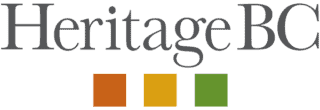- Heritage 101
- Advocacy
- Accessibility for Historic Places
- Climate & Sustainability
- Cultural Maps
- Heritage Place Conservation
- Heritage Policy & Legislation
- Homeowners
- Intangible Cultural Heritage
- Reconciliation
- Indigenous Cultural Heritage
- Setting the Bar: A Reconciliation Guide for Heritage
- 1. Heritage and Reconciliation Pledge
- 2. Acknowledging Land and People
- 3. Celebrating Days of Recognition and Commemoration
- 4. With a Commitment to Learn
- 5. Committing to Strategic Organizational Diversity
- 6. Mission-Making Room for Reconciliation
- 7. Possession, Interpretation, Repatriation and Cultural Care
- 8. Shared Decision Making
- 9. Statements of Significance and other heritage planning documents
- 10. Heritage Conservation Tools, Local Government Act
- Racism: Do Not Let the Forgetting Prevail
- Taking Action: resources for diversity and inclusion
- Webinars On-Demand
Heritage Conservation Areas: Objectives
 A heritage plan, to be effective, should be aligned with the Official Community Plan (OCP), including harmonized objectives and strategies. In this way, the OCP and the heritage plan will reinforce each other.
A heritage plan, to be effective, should be aligned with the Official Community Plan (OCP), including harmonized objectives and strategies. In this way, the OCP and the heritage plan will reinforce each other.
The designation of a heritage conservation area must state the objectives of the designation. “Objectives are concrete activities that can be achieved within a specified time period,” according to Heritage Planning (source). “They are the things that can be done to achieve a goal. Since there are a number of different ways to realize almost any goal, most goals can have a number of different specific objectives.”
The same document offers several key points for preparing objectives:
- Objectives should specify a target;
- Where appropriate, the magnitude of changes expected as a result of achieving that target should be specified;
- A time frame should be stated;
- Objectives should be simple and clear; jargon should be avoided;
- Objectives should be realistic; unachievable objectives can lead to a lack of confidence in the program;
- Objectives should not have to be absolutely defensible to all who read them; they are working statements;
- What is most important is the degree to which they succeed in attaining program goals.
Examples of objectives
Following are the objectives found in four HCA designations; they are preceded with a brief summary.
Note: The summary and examples are offered to exemplify objectives that are used to support HCAs. This is not intended to provide an exhaustive or authoritative list, as each local government will develop specific objectives related to each HCA.
Summary of the following excerpts:
- To recognize and enhance history;
- To benefit present and future generations;
- To manage alterations, development, redevelopment, construction, and demolition in order to retain the heritage value of the area;
- To promote conservation, restoration, rehabilitation, and renovation;
- To maintain character of area (e.g. layout, features);
- To establish guidelines for new construction and alterations that are sympathetic to heritage environment;
- To support local government planning goals (e.g. livability, residential mix, tourism, zoning);
- To regulate infill, subdivision;
- To manage greenspaces, landscapes;
- To acknowledge and work with non-confirming standards;
- To communicate heritage value;
The objectives of the designation of the Queen’s Park Heritage Conservation Area (New Westminster) are to:
- recognize and protect the historic nature of the neighbourhood for the benefit of present and future generations;
- ensure that all building alterations and property development or redevelopment within the neighbourhood, including landscape design, respects the history and enhances the heritage character and heritage value of the neighbourhood;
- promote conservation, restoration, rehabilitation and renovation of the heritage buildings in the neighbourhood;
- maintain current neighbourhood layout and residential lot sizes to protect the park-like character of the area;
- accommodate development, including infill, that is consistent with the existing heritage buildings and enhances the heritage character of the neighbourhood.
(source)
The objectives of the designation of the Ioco Townsite Heritage Conservation Area are:
- To recognize and enhance the historic nature of the Ioco Townsite for the benefit of present and future generations;
- To encourage the preservation, rehabilitation, restoration, or reconstruction of existing structures within the Townsite;
- To accommodate and manage infill development on existing lots to ensure that new buildings constructed within this historic area are designed and maintained so as not to detract from the overall effect and character of the buildings, structures, land and listed;
- To create an opportunity for a living, neo-traditional, pedestrian oriented, revitalized, waterfront community that allows for a wide range of residential, commercial, cultural, institutional and recreational uses;
- To re-establish the existing bowling green and baseball field for use by the community;
- To ensure that the buildings [listed in the area] are neither demolished nor altered in any way that is not consistent with their original design or appearance;
- To retain the buildings [listed in this area] in their original location to the greatest extent where practical and legally possible. Where relocation is essential, especially when buildings are located directly within watercourses, an appropriate new location will be determined within the context of the above referenced area plan. As a preliminary step, an illustrative concept plan has been prepared through the HCA process to identify potential infill and redevelopment opportunities…;
- The City is committed to working with the property owners in arriving at a comprehensive area plan and appropriate rezoning for the Ioco Townsite (and as well the surrounding lands) that will deal in greater detail and refine the potential vision expressed by the illustrative concept plan. The area plan and rezoning process will engage the community for input;
- To support the use of reduced setbacks for existing and proposed buildings and structures from watercourses, down to 5 metres, so that the historic fabric of the central part of the site can be re-established, and the existing heritage buildings be adapted for reuse. This setback relaxation is supported in principle as a key condition of the Heritage Conservation Area Bylaw and is an essential component in revitalizing the existing Townsite;
- To accept the existing non-conforming road standards within the Townsite.
(source)
The objectives of the designation of the Moody Centre Heritage Conservation are:
- to recognize and enhance the historic nature of Moody Centre for the benefit of present and future generations;
- to ensure that all building restorations, rehabilitations, renovations or alterations, and property development or redevelopment within the Moody Centre Heritage Conservation Area respects the history and enhances the heritage character and heritage value of Moody Centre;
- to promote conservation, restoration, and heritage sensitive rehabilitation and renovation of the heritage buildings in the Moody Centre Heritage Conservation Area;
- to regulate subdivision within the Moody Centre Heritage Conservation Area; and
- to accommodate infill development that is consistent with the existing heritage buildings and enhances the heritage character of Moody Centre.
(source)
The objectives of the designation of the Murrayville Heritage Conservation Area are to:
- Recognize and enhance the historic nature of Murrayville for the benefit of present and future generations;
- Ensure that all building restorations, rehabilitations, renovations or alterations, and property development or redevelopment within the Area, respects the history and enhances the heritage character of Murrayville;
- Promote preservation, restoration and rehabilitation of heritage buildings
- Respect the design of existing contemporary buildings;
- Accommodate infill development that is consistent with the existing heritage buildings and enhances the heritage character of the Area; and
- Communicate the historic value of the area through a variety of means including complimentary streetworks, historic interpretation, events and neighbourhood celebrations.
(source)
